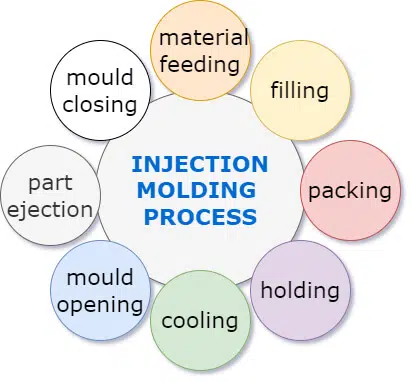Molding Processes And Their Types
Various types of plastic moulding processes are used for forming plastics into various products of varying sizes and shapes to be used in different applications. Upon heating, plastic changes from solid to liquid and softens.
As a result, various products can easily be fabricated. When the plastic melts, it is inserted into a mold, and after it has cooled it is removed from the mold, and the plastic product is ready for use.

A plastic product can be made in a variety of ways such as casting, injection molding, blow molding, compression molding, and rotational molding methods.
In this section, we will discuss casting first. It is the final step in the molding process to complete the casting process. Heat is applied to the plastic until it becomes liquid, and then the plastic is placed into a mold. This process is carried out without the use of additional force.
During the casting process, the liquid is solidified by various methods such as evaporation, cooling, chemical treatment, or the application of external heat. Generally, only a small amount of equipment is required and it is not very costly. There is very little stress on the inside of the products. For the casting of Nylon type 6 and polyurethanes, a material that is widely used is nylon type 6 and polyurethane. These materials are primarily used for the production of complex designs.
An injection molding process is the next. Three steps are involved. Designing the product is the first step. Testing the product then designing the mold is the second step. For molds, different metals are utilized to make them strong and durable. Third, a heating barrel is fed with thermoplastic material from a hopper.
By means of a large screw, the thermoplastic is heated and injected into the mold. Pressure is then applied to the mold to cool it. Upon cooling, the product is removed from the mold and this cycle is repeated more and more to make many products. Plastic cup lids, car dashboards, and bottle caps are all made through injection molding.
Blow molding tops the list. The blow molding process involves melting plastic and creating a hollow tube out of it. The tube is inserted into the mold and blown into the mold, where it is inflated according to the mold's size and shape. It cools down by blowing cold air, which is ejected automatically. Usually, hollow products like milk containers and water bottles are made using the blow molding process.
A compression molding process, however, is more labor-intensive. Unlike compression molding, which is used for small-scale production, compression molding is more complicated.
During the process, molten plastic is poured into a mold and pressed with high pressure with a second mold. Before cooling, the plastic is compressed in these molds. As a result of removing the mold, we get a product that is strong and has the desired size and shape. This is how car tires are made.
During rotational molding, a mold is filled with plastic powder. When the mold is filled with plastic powder, it is heated and rotated. The plastic melts, coating the mold walls. From there, it is cooled by air.
The product is ejected from the mold once it has solidified. With rotational molding, products such as water storage tanks, containers, crates, traffic dividers, furniture, and toys can be manufactured.